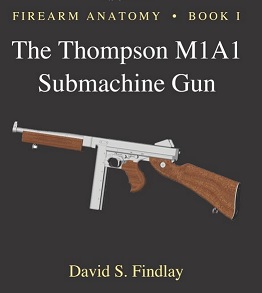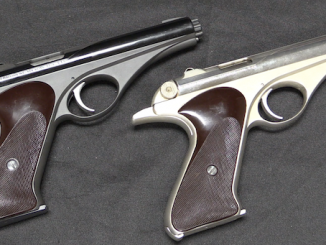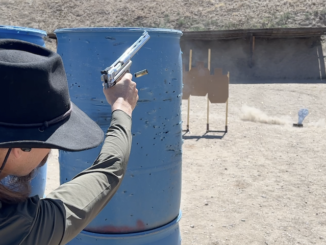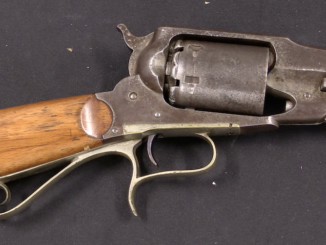 One of the questions I have gotten quite a few times is what resource I would recommend for folks who are interested in the technical engineering aspects of firearms design. It’s always been a tough question, because apart from Chinn’s multi-volume work (which is crazy expensive to buy in print now, although it is available online) there are very few book that I’m aware of. Until now! I just got a copy of David S. Findlay’s new book on the Thompson M1A1, and it is exactly the work that an aspiring firearms designer should get a copy of.
One of the questions I have gotten quite a few times is what resource I would recommend for folks who are interested in the technical engineering aspects of firearms design. It’s always been a tough question, because apart from Chinn’s multi-volume work (which is crazy expensive to buy in print now, although it is available online) there are very few book that I’m aware of. Until now! I just got a copy of David S. Findlay’s new book on the Thompson M1A1, and it is exactly the work that an aspiring firearms designer should get a copy of.
The title doesn’t really convey the scope of the book – it is not about the history of the Thompson, or the development of its different variations. Instead, Findlay (who is a second-generation firearms engineer with 7 patents to his name) takes the M1A1 and provides a rigorous and detailed analysis of its mechanism. The M1A1 was the final simplified version of the Thompson, which abandoned the Blish system and worked on a plain blowback concept. Findlay’s analysis looks at the elements of bolt weight, spring force, friction, gravity, propellant gas movement, buffer elasticity, and other factors in determining rate of fire of the gun. There is as much math as text in the book, as all of the calculations to understand these factors are drawn out in detail. In addition, the calculations to determine the characteristics of oval magazine springs are also included in their own dedicated chapter.
The book is 340 pages in total, and the mathematical analysis of the gun only takes up the first 75 or so. The remainder of the volume consists of a complete set of reverse-engineered technical drawings for every part of the M1A1, right down to the pins. These drawings are further broken down into discrete machining step. The barrel, for example, is covered by 9 separate drawings for the initial cutoff, drill & ream, rifling, hub turning, hub threading, contouring, chambering, finishing radii, and final finishing. The upper receiver has 38 individual drawings, starting from a single billet of material. These are not blurred and fuzzy copies of original blueprints, but fully dimensioned computer-printed drawings reverse-engineered from an M1A1 by a professional firearms engineer.
In short, if you want to know how to build a Thompson, with the supporting knowledge and understanding to design and build a blowback firearm of your own design, this is exactly the book you have been looking for. It is so significantly distinct from material like P.A. Luty’s that I am hesitant to even bring up the comparison, as Findlay’s work is at a whole different level. As he discussed in the preface, Findlay wrote the book to stimulate and support interest in firearms design – historically speaking, we are due for another major breakthrough in firearms technology and this book is for the people who will go on to make the next innovation.
I should point out that you know a book will be good when it had to be approved by the State Department for International Traffic in Arms Regulations compliance prior to publication… 🙂
So, if you are one of the people who has asked me where to find a book like this, get thee to Amazon and pick up a copy! It’s the best firearms engineering book I have seen, if not the only one (other than Chinn’s) and the more technically disposed you are, the more you will appreciate and learn from it.




I can recommend one “how to design firearms?” book but it is Russian language, but it included many unique drawings (for example firearms details cross-sections):
Основания проектирования автоматического оружия. М.: Воениздат, 1940
As you can see the book was printed in 1940 so it’s covering 1930s era and earlier weapons. It’s cover the automatic firearms design and their mathematical description.
Daweo, thanks for sharing the information on a very good but relatively unknown ( at least here in the U.S. ) source for small arms design — much appreciated!
It will be joining my copy of Chinn vol 4, Stuart Ottesson’s books on bolt actions and bench rest actions, and this: http://www.amazon.com/Brasseys-Essential-Guide-Military-Small/dp/1857531078/ref=sr_1_1?s=books&ie=UTF8&qid=1386868849&sr=1-1&keywords=brasseys+essential+guides
Allsop, Popelinsky et al covers mostly Czech practice. It’s actually coming down in price, it peaked at over £700 british a few years back.
There was a little book from the 1970s covered SMG design theory, and had drawings for a STEn and a PPSh. I’ll look the bibliographic details out.
Brassey’s — I haven’t looked closely at a Brassey’s publication in about thirty-plus years. Thanks for the reminder, Keith!
The kind of book folks like us may need a bib to read with (on account of the constant drooling). Must have!
i know what i am going to get myself for christmas
Most of mathematical explanations come after invention of a small firearm design.
There is some exception like Pal Dedai Kiraly who invented the lever delay blowback
principle that the patent of which was granted thereafter. In the US Patent Serial
Number 1073908, in the year 1913, Kiraly and Lovaksz explained “Momentum Sharing On
Partialy Accerelated Mass” based delaying actions. Interestingly, Chinn’s books
have not sufficient explanations on this invention.(At least the copies I found).
“Most of mathematical explanations come after invention of a small firearm design.”
It is a better way as it is impossible to build and mass-produce fancy mechanism which works only in theory (see Blish lock) – if you’re excepting that mechanism will work because you calculate it, you’re prone to neglect negative field trials results.
It has been said that the development of the science of thermodynamics owes everything to the heat engine, but that the development of the heat engine owes virtually nothing to the science of thermodynamics.
The internal ballistics part of a gun is of course a heat engine.
To a certain extent that assertion of practice first, understanding later, might be true, but there are major exceptions to it, for example, James Watt was the first person to actually work out what steam (heat) was doing inside an engine, and that understanding lead to advances such as the “indicator” which allowed the pressure-displacement of a working engine to be recorded graphically and then analysed in terms of an ideal theoretical cycle, and of course to the external condenser.
Rudolf Deisel developed an engine to operate on the theoretical Carnot cycle, rather than tinkering with an engine then working out how it worked afterwards.
More directly with guns, Mendeleev (periodic table man) was able to use basic chemical reasoning (avogadro and gas theories) to determine that straight nitro cellulose propellants gave more propulsive effect for a given ammount of heat released, than double base, nitro cellulose and nitroglycerine propellants.
The 17th century work of Newton and the over two thousand year old work of Euclid allowed various delayed blowback systems to be worked out theoretically, although significant practical work was needed to develop them into reliable guns.
The mathematical understanding of the strength of the working parts of guns has come very late. Military bolt action rifles had already reached their peak of development, with the German adoption of the Mauser ’98, the same year that Kirsch published the first comparatively simple stress equations http://en.wikipedia.org/wiki/Kirsch_equations
Although gunsmiths had understood the importance of good surface finish and of rounded rather than sharp corners on stressed parts for a couple of hundred years or more, Mathematical understanding of stress concentration didn’t develop until Griffiths’ work in the 1920s and ’30s. Even then, Griffiths’ work was considered controversial, and acccording to Gordon (author of “the new science of strong materials”, and “Structures” – both very highly recommended) Griffiths’ theories were definitely not taught when he studied naval architecture -despite the unfortunate habit ships had of snapping in half.
Griffiths was also not appreciated by the higher ranks of the royal air force, whom he reported to, especially after his lab caught fire and it emerged that he was studying glass as a “model material”. His superiors were totally baffled, as they could see no role for glass in aircraft, why was he not working with aircraft materials like aluminium?
Mathematical methods which allowed plastic rather than just elastic behaviour to be modelled and which allowed stresses and deformations to be calculated in complex three dimensional shapes emerged, in the late 1930s and early 1940s (itirative “relaxation” methods and finite element, finite difference and boundary element formulae) although the computing power to run detailed 3d models was not readily available until the late 1990s, and even then, it could take several days for a model to run.
Up to the 1940s a “computer” was a mathematically able human (usually female -males don’t tend to have the necessary patience or persistence) with a pencil, paper, and book of mathematical tables.
However, the invention of clear plastics and of cheap plastic polarizing filters did allow the physical modelling of stresses by the time consuming but rather beautiful process of photoelasticity, where a warmed clear plastic model was stressed, and then allowed to cool, locking in the stresses, and on sectioning, the coloured interference fringes, proportional to the stresses incurred could be viewed and measured in plane polarized light.
Thompson Submachineguns at early development stage,
was thought to use rifle level bottlenecked rounds
which needing a locking mechanism for safe use, and
“Blish Lock” based on “Static Friction” was considered
suitable for this purpose. However, eventual round was
a pistol cartridge but, firing mechanism was kept
unchanged. A reasonable time of use prooved the lock
mechanism being unnecessary and it was deleted. In fact,
Blish Lock did work and though not stated clearly, it
was the part of Savage rotating barrel lock.
Nice gun but fires to fast in my oppinion
One book that comes in mind, it contains blueprints of STEN and PPSH41 as well as some theory and math, is from George Dmitrieff.
It is a mixed bag, and leaves a lot to be desired.
Bringing up late mr. Luty, I’m sure a huge setback in his (expedient) firearm development was multi years incarceration that effectively blocked the work and research he could done in that field, and after release it was no better as he was in extremely gun unfriendly state.
Nevertheless, his work is (was?) a breakthrough in some way, as it simplified and brought the firearm production process to the masses, compared to the tools and machines friendly books that initially shocked and scared the reader.
Here’s one for you: Werner, Malcolm J. (2010-05-01). The Colt 1911 Pistol – a Mechanical Engineer’s Perspective. Available only from Amazon, and only as a Kindle edition. Here’s what I wrote about it almost two years ago:
http://weaponsman.com/?p=1442
Oh crap! I just checked Amazon and there’s a “much improved second edition:” The Colt 1911 – An Engineer’s Perspective
Perhaps Ian will edit this link so he gets affiliate credit for those of us that blow $1.95 on Werner’s book (HIGHLY recommended). [Ian: done!]
This book should be exactly what some readers of Forgotten Weapons want! I know I was delighted with it.
I just got my copy of Findlay’s book and am rather disappointed.
It is NOT a comprehensive engineering study by any stretch of the imagination. It’s a 2nd order approximation (i.e. includes friction, etc) to the cyclic rate calculation for a blowback submachine gun and what appears to be a complete set of engineering drawings for an M1A1. Possibly useful if you want to make one, but it’s hard to see much value beyond that. Of course, if engineering level mechanics is not something you know, it might be more useful.
Things not included are topics like hoop stresses (how thick does the barrel need to be), barrel-receiver connection stresses (what threads are needed), etc. So the most important things have been left out.
In short, you will not learn much about designing firearms from this book. But you will be able to make a scale model of an M1A1.
NB It’s “Book on Demand” printed. Well made, but long lead time. The ITAR approval is just a CYA, not evidence of thoroughness.
It took me a while to figure out which books you guys were referring to “Chinn’s”
You can download and read them from the Internet Archive
https://archive.org/details/TheMachineGunVolume1ByGeorgeMChinn
I hope this helps.
I’m new to firearms design, it’s not easy finding information on the topic.